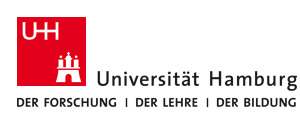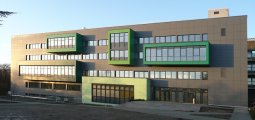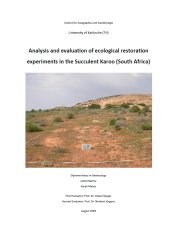
|

Department of Biology Institute of Plant Science and Microbiology |
| Division BEE > BEE Press: Theses > 10.7809/thesis.diplom.005 |
|
Diplom thesis Open Access Analysis and evaluation of ecological restoration experiments in the Succulent Karoo (South Africa)
Sarah Meyer Language: English Published: Aug 09 First published online: 2013-02-15 DOI: 10.7809/thesis.diplom.005
Author contact: Keywords: construction work; degradation; experiment; Namaqualand; rangeland; restoration; soil; South Africa; Succulent Karoo; vegetation English abstract: Introduction: The aim of this study was to examine the effects of different (active and passive) restoration techniques on soil and vegetation of degraded rangeland at two sites in the Namaqualand of the Succulent Karoo, four years after their implementation. Also, the effects of total annual and seasonal rainfall on the relative abundance of individuals of species within different life form groups were investigated for the four subsequent years after treatment implementation. Methods: One study site is located in the Knersvlakte and aims to reverse the negative effects created through the construction of an underground water pipeline through quartz fields and zonal vegetation on communal rangeland of the farm Ratelgat. The other study site is located in the Soebatsfontein commonage within the Hardeveld bioregion and intends to restore communal farm land which is degraded due to overgrazing by sheep in the past, before the farmland had been handed over to the community.The applied treatments for Ratelgat were "scattering of quartz stones + levelling", "planting + levelling", "levelling" and "no treatment" for plots located on quartz fields and "brushpacking + levelling" on non quartz field plots. At Soebatsfontein one part was fenced to exclude grazing the other part was left unfenced. Within each part four treatments were implemented: "small stones heaps", "brushpacking", "covering of the plots with manure and palm leaves" and "controls". The effect of the restoration treatments on soil properties of Soebatsfontein was examined with a MANOVA with pH, logEC and C/N ratio as dependent variables, the active treatments and grazing as fixed factors and study site as covariate. Differentiating effects of the active restoration treatments and grazing (only Soebatsfontein) on vegetation parameters (total cover, number of individuals and species richness) were assessed with ANOVAs', Kruskal-Wallis or Mann-Whitney U tests, respectively. The relationship between total annual or seasonal rainfall and relative abundance of species at Soebatsfontein was quantified using multiple linear regressions. The potential negative setup effect of the "brushpack and leveling" treatment at Ratelgat was assessed with a comparison of species richness and number of individuals before and immidiately after treatment installation. Results: For Soebatsfontein, the treatments "manure & palm fronds" and "brushpacking" increased pH, electrical conductivity, total nitrogen and total carbon content of the soil at both camps significantly. If compared to resting, grazing significantly increased total cover of perennial species at Patrysegat but significantly lowered total cover of all species and annuals at Quaggasfontein in 2008. Resting at Quaggasfontein resulted in significantly lowered number of "annual species" and "all species". Species richness was significantly positive influenced by grazing at Patrysegat and negative at Quaggasfontein. Also the results for the active treatments were ambiguous. The "brushpack" treatment showed significant negative effects on individual numbers of perennials as well as perennial species richness in 2005 and significantly increased annual cover in 2006. For the "manure & palm fronds" treatment annual cover increased significantly in 2006 but perennial species richness was significantly negative influenced in 2005.The obtained models for annual or seasonal rainfall and relative abundance of different life form groups were highly significant but further partition into seasons did not improve the quality of the models. For Ratelgat significant treatment effects were found for the Cephalophyllum spissum-Community with a significant increase of individual numbers under the "planting" treatment in 2005. The installation of the "brushpack" treatment significantly lowered number of individuals and species richness immediately after installation but the development under the treatment was very positive over the subsequent years. Conclusion: Grazing exclusion as a passive restoration treatment seems to be more important for areas under high grazing pressure than for light grazed ones. The applied treatments "brushpacking" and "manure & palm fronds" cannot be recommended without caution because of the significant negative effects which are ascribed to destructive impacts during their installation and potential shading effects. The positive effect of the brushpack treatment on the zonal vegetation at Ratelgat leads to the conclusion that brushpacks are a valuable restoration method and it is advised to apply them in the future less dense as it had been applied in Soebatsfontein (i.e., 90%). The treatments "planting" (significant), "stones" and "levelling", listed by descending effect were able to improve number of individuals for all species within the C. spissum-Community and can be assumed to be also suitable for the restoration of other quartz field communities.
Suggested citation: |
| Imprint / last update: 2023-01-13 by: Gerhard Muche | search |
